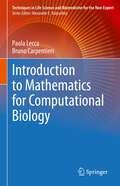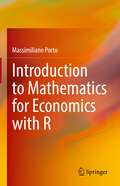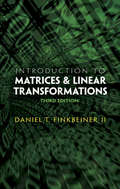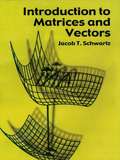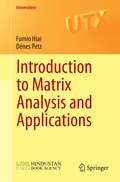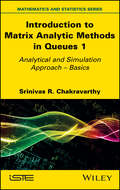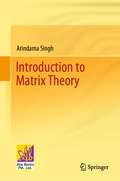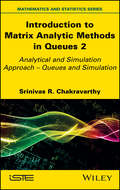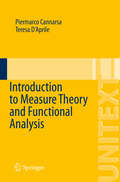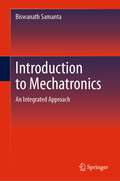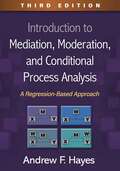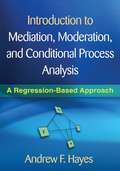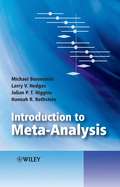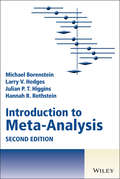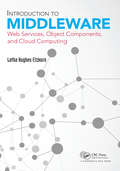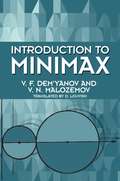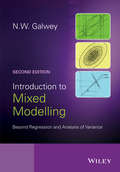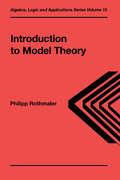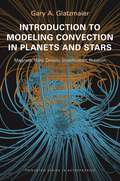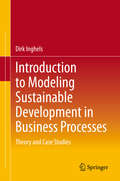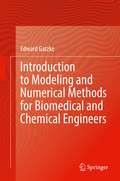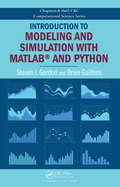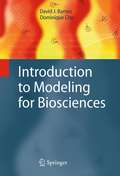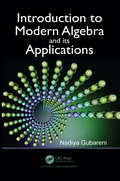- Table View
- List View
Introduction to Mathematics for Computational Biology (Techniques in Life Science and Biomedicine for the Non-Expert)
by Paola Lecca Bruno CarpentieriThis introductory guide provides a thorough explanation of the mathematics and algorithms used in standard data analysis techniques within systems biology, biochemistry, and biophysics. Each part of the book covers the mathematical background and practical applications of a given technique. Readers will gain an understanding of the mathematical and algorithmic steps needed to use these software tools appropriately and effectively, as well how to assess their specific circumstance and choose the optimal method and technology. Ideal for students planning for a career in research, early-career researchers, and established scientists undertaking interdisciplinary research.
Introduction to Mathematics for Economics with R
by Massimiliano PortoThis book provides a practical introduction to mathematics for economics using R software. Using R as a basis, this book guides the reader through foundational topics in linear algebra, calculus, and optimization. The book is organized in order of increasing difficulty, beginning with a rudimentary introduction to R and progressing through exercises that require the reader to code their own functions in R. All chapters include applications for topics in economics and econometrics. As fully reproducible book, this volume gives readers the opportunity to learn by doing and develop research skills as they go. As such, it is appropriate for students in economics and econometrics.
Introduction to Matrices and Linear Transformations: Third Edition
by Daniel T. Finkbeiner IIThis versatile undergraduate text can be used in a variety of courses in linear algebra. It contains enough material for a one-year course, and it also serves as a support text and reference. A combination of formal theory and related computational techniques, it includes solutions to selected exercises. 1978 edition.
Introduction to Matrices and Vectors (Dover Books on Mathematics)
by Jacob T. SchwartzRealizing that matrices can be a confusing topic for the beginner, the author of this undergraduate text has made things as clear as possible by focusing on problem solving, rather than elaborate proofs. He begins with the basics, offering students a solid foundation for the later chapters on using special matrices to solve problems.The first three chapters present the basics of matrices, including addition, multiplication, and division, and give solid practice in the areas of matrix manipulation where the laws of algebra do not apply. In later chapters the author introduces vectors and shows how to use vectors and matrices to solve systems of linear equations. He also covers special matrices -- including complex numbers, quaternion matrices, and matrices with complex entries -- and transpose matrices; the trace of a matrix; the cross product of matrices; eigenvalues and eigenvectors; and infinite series of matrices. Exercises at the end of each section give students further practice in problem solving. Prerequisites include a background in algebra, and in the later chapters, a knowledge of solid geometry. The book was designed as an introductory text for college freshmen and sophomores, but selected chapters can also be used to supplement advanced high school classes. Professionals who need a better understanding or review of the subject will also benefit from this concise guide.
Introduction to Matrix Analysis and Applications
by Fumio Hiai Dénes PetzMatrices can be studied in different ways. They are a linear algebraic structure and have a topological/analytical aspect (for example, the normed space of matrices) and they also carry an order structure that is induced by positive semidefinite matrices. The interplay of these closely related structures is an essential feature of matrix analysis. This book explains these aspects of matrix analysis from a functional analysis point of view. After an introduction to matrices and functional analysis, it covers more advanced topics such as matrix monotone functions, matrix means, majorization and entropies. Several applications to quantum information are also included. Introduction to Matrix Analysis and Applications is appropriate for an advanced graduate course on matrix analysis, particularly aimed at studying quantum information. It can also be used as a reference for researchers in quantum information, statistics, engineering and economics.
Introduction to Matrix Analytic Methods in Queues 1: Analytical and Simulation Approach - Basics
by Srinivas R. ChakravarthyMatrix-analytic methods (MAM) were introduced by Professor Marcel Neuts and have been applied to a variety of stochastic models since. In order to provide a clear and deep understanding of MAM while showing their power, this book presents MAM concepts and explains the results using a number of worked-out examples.This book&’s approach will inform and kindle the interest of researchers attracted to this fertile field. To allow readers to practice and gain experience in the algorithmic and computational procedures of MAM, Introduction to Matrix Analytic Methods in Queues 1 provides a number of computational exercises. It also incorporates simulation as another tool for studying complex stochastic models, especially when the state space of the underlying stochastic models under analytic study grows exponentially.The book&’s detailed approach will make it more accessible for readers interested in learning about MAM in stochastic models.
Introduction to Matrix Theory
by Arindama SinghThis book is designed to serve as a textbook for courses offered to undergraduate and postgraduate students enrolled in Mathematics. Using elementary row operations and Gram-Schmidt orthogonalization as basic tools the text develops characterization of equivalence and similarity, and various factorizations such as rank factorization, OR-factorization, Schurtriangularization, Diagonalization of normal matrices, Jordan decomposition, singular value decomposition, and polar decomposition. Along with Gauss-Jordan elimination for linear systems, it also discusses best approximations and least-squares solutions. The book includes norms on matrices as a means to deal with iterative solutions of linear systems and exponential of a matrix. The topics in the book are dealt with in a lively manner. Each section of the book has exercises to reinforce the concepts, and problems have been added at the end of each chapter. Most of these problems are theoretical, and they do not fit into the running text linearly. The detailed coverage and pedagogical tools make this an ideal textbook for students and researchers enrolled in senior undergraduate and beginning postgraduate mathematics courses.
Introduction to Matrix-Analytic Methods in Queues 2: Analytical and Simulation Approach - Queues and Simulation
by Srinivas R. ChakravarthyMatrix-analytic methods (MAM) were introduced by Professor Marcel Neuts and have been applied to a variety of stochastic models since. In order to provide a clear and deep understanding of MAM while showing their power, this book presents MAM concepts and explains the results using a number of worked-out examples. This book's approach will inform and kindle the interest of researchers attracted to this fertile field. To allow readers to practice and gain experience in the algorithmic and computational procedures of MAM, Introduction to Matrix-Analytic Methods in Queues 2 provides a number of computational exercises. It also incorporates simulation as another tool for studying complex stochastic models, especially when the state space of the underlying stochastic models under analytic study grows exponentially. This book's detailed approach will make it more accessible for readers interested in learning about MAM in stochastic models.
Introduction to Measure Theory and Functional Analysis
by Piermarco Cannarsa Teresa D'AprileThis book introduces readers to theories that play a crucial role in modern mathematics, such as integration and functional analysis, employing a unifying approach that views these two subjects as being deeply intertwined. This feature is particularly evident in the broad range of problems examined, the solutions of which are often supported by generous hints. If the material is split into two courses, it can be supplemented by additional topics from the third part of the book, such as functions of bounded variation, absolutely continuous functions, and signed measures. This textbook addresses the needs of graduate students in mathematics, who will find the basic material they will need in their future careers, as well as those of researchers, who will appreciate the self-contained exposition which requires no other preliminaries than basic calculus and linear algebra.
Introduction to Mechatronics: An Integrated Approach
by Biswanath SamantaThis textbook presents mechatronics through an integrated approach covering instrumentation, circuits and electronics, computer-based data acquisition and analysis, analog and digital signal processing, sensors, actuators, digital logic circuits, microcontroller programming and interfacing. The use of computer programming is emphasized throughout the text, and includes Matlab for system modeling, simulation, and analysis; LabVIEW for data acquisition and signal processing; and C++ for Arduino-based microcontroller programming and interfacing. Prof. Samanta provides numerous examples along with appropriate program codes, for simulation and analysis, that are discussed in detail to illustrate the concepts covered in each section. The book also includes the illustration of theoretical concepts through the virtual simulation platform Tinkercad to provide students virtual lab experience.
Introduction to Mediation, Moderation, and Conditional Process Analysis: A Regression-Based Approach
by Andrew F. HayesAcclaimed for its thorough presentation of mediation, moderation, and conditional process analysis, this book has been updated to reflect the latest developments in PROCESS for SPSS, SAS, and, new to this edition, R. Using the principles of ordinary least squares regression, Andrew F. Hayes illustrates each step in an analysis using diverse examples from published studies, and displays SPSS, SAS, and R code for each example. Procedures are outlined for estimating and interpreting direct, indirect, and conditional effects; probing and visualizing interactions; testing hypotheses about the moderation of mechanisms; and reporting different types of analyses. Readers gain an understanding of the link between statistics and causality, as well as what the data are telling them.
Introduction to Mediation, Moderation, and Conditional Process Analysis: A Regression-Based Approach (Methodology in the social sciences)
by Andrew F. HayesThis book explains the fundamentals of mediation and moderation analysis and their integration as "conditional process analysis." Procedures are described for testing hypotheses about the mechanisms by which causal effects operate, the conditions under which they occur, and the moderation of mechanisms.
Introduction to Meta-Analysis
by Hannah R. Rothstein Michael Borenstein Larry V. Hedges Julian P. HigginsThis book provides a clear and thorough introduction to meta-analysis, the process of synthesizing data from a series of separate studies. Meta-analysis has become a critically important tool in fields as diverse as medicine, pharmacology, epidemiology, education, psychology, business, and ecology. Introduction to Meta-Analysis:Outlines the role of meta-analysis in the research processShows how to compute effects sizes and treatment effectsExplains the fixed-effect and random-effects models for synthesizing dataDemonstrates how to assess and interpret variation in effect size across studiesClarifies concepts using text and figures, followed by formulas and examplesExplains how to avoid common mistakes in meta-analysisDiscusses controversies in meta-analysisFeatures a web site with additional material and exercisesA superb combination of lucid prose and informative graphics, written by four of the world's leading experts on all aspects of meta-analysis. Borenstein, Hedges, Higgins, and Rothstein provide a refreshing departure from cookbook approaches with their clear explanations of the what and why of meta-analysis. The book is ideal as a course textbook or for self-study. My students, who used pre-publication versions of some of the chapters, raved about the clarity of the explanations and examples. David Rindskopf, Distinguished Professor of Educational Psychology, City University of New York, Graduate School and University Center, & Editor of the Journal of Educational and Behavioral Statistics.The approach taken by Introduction to Meta-analysis is intended to be primarily conceptual, and it is amazingly successful at achieving that goal. The reader can comfortably skip the formulas and still understand their application and underlying motivation. For the more statistically sophisticated reader, the relevant formulas and worked examples provide a superb practical guide to performing a meta-analysis. The book provides an eclectic mix of examples from education, social science, biomedical studies, and even ecology. For anyone considering leading a course in meta-analysis, or pursuing self-directed study, Introduction to Meta-analysis would be a clear first choice. Jesse A. Berlin, ScD Introduction to Meta-Analysis is an excellent resource for novices and experts alike. The book provides a clear and comprehensive presentation of all basic and most advanced approaches to meta-analysis. This book will be referenced for decades. Michael A. McDaniel, Professor of Human Resources and Organizational Behavior, Virginia Commonwealth University
Introduction to Meta-Analysis
by Hannah R. Rothstein Michael Borenstein Larry V. Hedges Julian P. HigginsThe new edition of the market-leading textbook, covering the latest developments in the rapidly growing field of meta-analysis This book provides a clear and thorough introduction to meta-analysis, the process of synthesizing data from a series of separate studies. The first edition of this text was widely acclaimed for the clarity of the presentation, and quickly established itself as the definitive text in this field. The fully updated second edition includes new and expanded content on avoiding common mistakes in meta-analysis, understanding heterogeneity in effects, publication bias, reporting the Knapp-Hartung Sidik-Jonkman adjustment, and more. Several brand-new chapters provide a systematic “how to” approach to performing and reporting a meta-analysis from start to finish. Written by four of the world’s foremost authorities on all aspects of meta-analysis, the new edition of Introduction to Meta-Analysis: Outlines the role of meta-analysis in the research process Shows how to compute effects sizes and treatment effects Explains the fixed-effect and random-effects models for synthesizing data Demonstrates how to assess and interpret variation in effect size across studies Explains how to avoid common mistakes in meta-analysis Discusses controversies in meta-analysis Includes access to a companion website containing videos, spreadsheets, data files, free software for prediction intervals, and step-by-step instructions for performing analyses using Comprehensive Meta-Analysis (CMA) ™
Introduction to Middleware: Web Services, Object Components, and Cloud Computing
by Letha Hughes Etzkorn"A stereotype of computer science textbooks is that they are dry, boring, and sometimes even intimidating. As a result, they turn students’ interests off from the subject matter instead of enticing them into it. This textbook is the opposite of such a stereotype. The author presents the subject matter in a refreshing story-telling style and aims to bring the Internet-generation of students closer to her stories."? --Yingcai Xiao, The University of Akron Introduction to Middleware: Web Services, Object Components, and Cloud Computing provides a comparison of different middleware technologies and the overarching middleware concepts they are based on. The various major paradigms of middleware are introduced and their pros and cons are discussed. This includes modern cloud interfaces, including the utility of Service Oriented Architectures. The text discusses pros and cons of RESTful vs. non-RESTful web services, and also compares these to older but still heavily used distributed object/component middleware. The text guides readers to select an appropriate middleware technology to use for any given task, and to learn new middleware technologies as they appear over time without being greatly overwhelmed by any new concept. The book begins with an introduction to different distributed computing paradigms, and a review of the different kinds of architectures, architectural styles/patterns, and properties that various researchers have used in the past to examine distributed applications and determine the quality of distributed applications. Then it includes appropriate background material in networking and the web, security, and encoding necessary to understand detailed discussion in this area. The major middleware paradigms are compared, and a comparison methodology is developed. Readers will learn how to select a paradigm and technology for a particular task, after reading this text. Detailed middleware technology review sections allow students or industry practitioners working to expand their knowledge to achieve practical skills based on real projects so as to become well-functional in that technology in industry. Major technologies examined include: RESTful web services (RESTful cloud interfaces such as OpenStack, AWS EC2 interface, CloudStack; AJAX, JAX-RS, ASP.NET MVC and ASP.NET Core), non-RESTful (SOAP and WSDL-based) web services (JAX-WS, Windows Communication Foundation), distributed objects/ components (Enterprise Java Beans, .NET Remoting, CORBA). The book presents two projects that can be used to illustrate the practical use of middleware, and provides implementations of these projects over different technologies. This versatile and class-tested textbook is suitable (depending on chapters selected) for undergraduate or first-year graduate courses on client server architectures, middleware, and cloud computing, web services, and web programming.
Introduction to Minimax (Dover Books on Mathematics)
by V. F. Dem’yanov V. N. Malozemov D. LouvishThis user-friendly text offers a thorough introduction to the part of optimization theory that lies between approximation theory and mathematical programming, both linear and nonlinear. Written by two distinguished mathematicians, the expert treatment covers the essentials, incorporating important background materials, examples, and extensive notes.Geared toward advanced undergraduate and graduate students of mathematical programming, the text explores best approximation by algebraic polynomials in both discrete and continuous cases; the discrete problem, with and without constraints; the generalized problem of nonlinear programming; and the continuous minimax problem. Several appendixes discuss algebraic interpolation, convex sets and functions, and other topics. 1974 edition.
Introduction to Mixed Modelling
by N. W. GalweyMixed modelling is very useful, and easier than you think!Mixed modelling is now well established as a powerful approach to statistical data analysis. It is based on the recognition of random-effect terms in statistical models, leading to inferences and estimates that have much wider applicability and are more realistic than those otherwise obtained.Introduction to Mixed Modelling leads the reader into mixed modelling as a natural extension of two more familiar methods, regression analysis and analysis of variance. It provides practical guidance combined with a clear explanation of the underlying concepts.Like the first edition, this new edition shows diverse applications of mixed models, provides guidance on the identification of random-effect terms, and explains how to obtain and interpret best linear unbiased predictors (BLUPs). It also introduces several important new topics, including the following:Use of the software SAS, in addition to GenStat and R.Meta-analysis and the multiple testing problem.The Bayesian interpretation of mixed models.Including numerous practical exercises with solutions, this book provides an ideal introduction to mixed modelling for final year undergraduate students, postgraduate students and professional researchers. It will appeal to readers from a wide range of scientific disciplines including statistics, biology, bioinformatics, medicine, agriculture, engineering, economics, archaeology and geography.
Introduction to Model Spaces and their Operators
by Javad Mashreghi Stephan Ramon Garcia William T. RossThe study of model spaces, the closed invariant subspaces of the backward shift operator, is a vast area of research with connections to complex analysis, operator theory and functional analysis. This self-contained text is the ideal introduction for newcomers to the field. It sets out the basic ideas and quickly takes the reader through the history of the subject before ending up at the frontier of mathematical analysis. Open questions point to potential areas of future research, offering plenty of inspiration to graduate students wishing to advance further.
Introduction to Model Theory (Algebra, Logic and Applications)
by Philipp RothmalerModel theory investigates mathematical structures by means of formal languages. So-called first-order languages have proved particularly useful in this respect.This text introduces the model theory of first-order logic, avoiding syntactical issues not too relevant to model theory. In this spirit, the compactness theorem is proved via the algebraically useful ultrsproduct technique (rather than via the completeness theorem of first-order logic). This leads fairly quickly to algebraic applications, like Malcev's local theorems of group theory and, after a little more preparation, to Hilbert's Nullstellensatz of field theory.Steinitz dimension theory for field extensions is obtained as a special case of a much more general model-theoretic treatment of strongly minimal theories. There is a final chapter on the models of the first-order theory of the integers as an abelian group. Both these topics appear here for the first time in a textbook at the introductory level, and are used to give hints to further reading and to recent developments in the field, such as stability (or classification) theory.
Introduction to Modeling Convection in Planets and Stars: Magnetic Field, Density Stratification, Rotation (Princeton Series in Astrophysics #24)
by Gary A. GlatzmaierThis book provides readers with the skills they need to write computer codes that simulate convection, internal gravity waves, and magnetic field generation in the interiors and atmospheres of rotating planets and stars. Using a teaching method perfected in the classroom, Gary Glatzmaier begins by offering a step-by-step guide on how to design codes for simulating nonlinear time-dependent thermal convection in a two-dimensional box using Fourier expansions in the horizontal direction and finite differences in the vertical direction. He then describes how to implement more efficient and accurate numerical methods and more realistic geometries in two and three dimensions. In the third part of the book, Glatzmaier demonstrates how to incorporate more sophisticated physics, including the effects of magnetic field, density stratification, and rotation. Featuring numerous exercises throughout, this is an ideal textbook for students and an essential resource for researchers. Describes how to create codes that simulate the internal dynamics of planets and stars Builds on basic concepts and simple methods Shows how to improve the efficiency and accuracy of the numerical methods Describes more relevant geometries and boundary conditions Demonstrates how to incorporate more sophisticated physics
Introduction to Modeling Sustainable Development in Business Processes: Theory and Case Studies
by Dirk InghelsSustainable development and corporate social responsibility drive countries, regions, and businesses to take environmental and social concerns into account when realizing economic objectives. A growing awareness of the connectedness between industrial, societal, and environmental systems might shift the way businesses will be operated. This book aims to help students and business practitioners use quantitative modeling in their pursuit to make business processes sustainable. Two approaches are introduced: linear optimization and system dynamics. Moreover, the quantification of the three different sustainability objectives is also addressed. Next to introducing the theoretical background, many real-life examples are discussed to demonstrate how the modelling techniques can be applied.
Introduction to Modeling and Numerical Methods for Biomedical and Chemical Engineers
by Edward GatzkeThis textbook introduces the concepts and tools that biomedical and chemical engineering students need to know in order to translate engineering problems into a numerical representation using scientific fundamentals. Modeling concepts focus on problems that are directly related to biomedical and chemical engineering. A variety of computational tools are presented, including MATLAB, Excel, Mathcad, and COMSOL, and a brief introduction to each tool is accompanied by multiple computer lab experiences. The numerical methods covered are basic linear algebra and basic statistics, and traditional methods like Newton’s method, Euler Integration, and trapezoidal integration. The book presents the reader with numerous examples and worked problems, and practice problems are included at the end of each chapter.
Introduction to Modeling and Simulation with MATLAB® and Python (Chapman & Hall/CRC Computational Science)
by Brian Guilfoos Steven I. GordonIntroduction to Modeling and Simulation with MATLAB and Python is intended for students and professionals in science, social science, and engineering that wish to learn the principles of computer modeling, as well as basic programming skills. The book content focuses on meeting a set of basic modeling and simulation competencies that were developed as part of several National Science Foundation grants. Even though computer science students are much more expert programmers, they are not often given the opportunity to see how those skills are being applied to solve complex science and engineering problems and may also not be aware of the libraries used by scientists to create those models. The book interleaves chapters on modeling concepts and related exercises with programming concepts and exercises. The authors start with an introduction to modeling and its importance to current practices in the sciences and engineering. They introduce each of the programming environments and the syntax used to represent variables and compute mathematical equations and functions. As students gain more programming expertise, the authors return to modeling concepts, providing starting code for a variety of exercises where students add additional code to solve the problem and provide an analysis of the outcomes. In this way, the book builds both modeling and programming expertise with a "just-in-time" approach so that by the end of the book, students can take on relatively simple modeling example on their own. Each chapter is supplemented with references to additional reading, tutorials, and exercises that guide students to additional help and allows them to practice both their programming and analytical modeling skills. In addition, each of the programming related chapters is divided into two parts – one for MATLAB and one for Python. In these chapters, the authors also refer to additional online tutorials that students can use if they are having difficulty with any of the topics. The book culminates with a set of final project exercise suggestions that incorporate both the modeling and programming skills provided in the rest of the volume. Those projects could be undertaken by individuals or small groups of students. The companion website at http://www.intromodeling.com provides updates to instructions when there are substantial changes in software versions, as well as electronic copies of exercises and the related code. The website also offers a space where people can suggest additional projects they are willing to share as well as comments on the existing projects and exercises throughout the book. Solutions and lecture notes will also be available for qualifying instructors.
Introduction to Modeling for Biosciences
by Dominique Chu David J. BarnesMathematical modeling can be a useful tool for researchers in the biological scientists. Yet in biological modeling there is no one modeling technique that is suitable for all problems. Instead, different problems call for different approaches. Furthermore, it can be helpful to analyze the same system using a variety of approaches, to be able to exploit the advantages and drawbacks of each. In practice, it is often unclear which modeling approaches will be most suitable for a particular biological question, a problem which requires researchers to know a reasonable amount about a number of techniques, rather than become experts on a single one. "Introduction to Modeling for Biosciences" addresses this issue by presenting a broad overview of the most important techniques used to model biological systems. In addition to providing an introduction into the use of a wide range of software tools and modeling environments, this helpful text/reference describes the constraints and difficulties that each modeling technique presents in practice, enabling the researcher to quickly determine which software package would be most useful for their particular problem. Topics and features: introduces a basic array of techniques to formulate models of biological systems, and to solve them; intersperses the text with exercises throughout the book; includes practical introductions to the Maxima computer algebra system, the PRISM model checker, and the Repast Simphony agent modeling environment; discusses agent-based models, stochastic modeling techniques, differential equations and Gillespie's stochastic simulation algorithm; contains appendices on Repast batch running, rules of differentiation and integration, Maxima and PRISM notation, and some additional mathematical concepts; supplies source code for many of the example models discussed, at the associated website http://www.cs.kent.ac.uk/imb/. This unique and practical guide leads the novice modeler through realistic and concrete modeling projects, highlighting and commenting on the process of abstracting the real system into a model. Students and active researchers in the biosciences will also benefit from the discussions of the high-quality, tried-and-tested modeling tools described in the book. Dr. David J. Barnes is a lecturer in computer science at the University of Kent, UK, with a strong background in the teaching of programming. Dr. Dominique Chu is a lecturer in computer science at the University of Kent, UK. He is an internationally recognized expert in agent-based modeling, and has also in-depth research experience in stochastic and differential equation based modeling.
Introduction to Modern Algebra and Its Applications
by Nadiya GubareniThe book provides an introduction to modern abstract algebra and its applications. It covers all major topics of classical theory of numbers, groups, rings, fields and finite dimensional algebras. The book also provides interesting and important modern applications in such subjects as Cryptography, Coding Theory, Computer Science and Physics. In particular, it considers algorithm RSA, secret sharing algorithms, Diffie-Hellman Scheme and ElGamal cryptosystem based on discrete logarithm problem. It also presents Buchberger’s algorithm which is one of the important algorithms for constructing Gröbner basis. Key Features: Covers all major topics of classical theory of modern abstract algebra such as groups, rings and fields and their applications. In addition it provides the introduction to the number theory, theory of finite fields, finite dimensional algebras and their applications. Provides interesting and important modern applications in such subjects as Cryptography, Coding Theory, Computer Science and Physics. Presents numerous examples illustrating the theory and applications. It is also filled with a number of exercises of various difficulty. Describes in detail the construction of the Cayley-Dickson construction for finite dimensional algebras, in particular, algebras of quaternions and octonions and gives their applications in the number theory and computer graphics.
